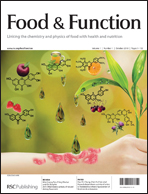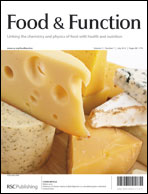This month sees the following articles in Food & Function that are in the top ten most accessed:-
Nuts, especially walnuts, have both antioxidant quantity and efficacy and exhibit significant potential health benefits
Joe A. Vinson and Yuxing Cai
Food Funct., 2012, Advance Article, DOI: 10.1039/C2FO10152A
Anti-inflammatory activity of natural dietary flavonoids
Min-Hsiung Pan, Ching-Shu Lai and Chi-Tang Ho
Food Funct., 2010,1, 15-31, DOI: 10.1039/C0FO00103A, Review Article
Effects of tea and coffee on cardiovascular disease risk
Siv K Bøhn, Natalie C Ward, Jonathan M Hodgson and Kevin D Croft
Food Funct., 2012, Advance Article, DOI: 10.1039/C2FO10288A
Mango fruit peel and flesh extracts affect adipogenesis in 3T3-L1 cells
Meng-Wong Taing, Jean-Thomas Pierson, Van L. T. Hoang, Paul N. Shaw, Ralf G. Dietzgen, Michael J. Gidley, Sarah J. Roberts-Thomson and Gregory R. Monteith
Food Funct., 2012, Advance Article, DOI: 10.1039/C2FO30073G, Paper
Review of in vitro digestion models for rapid screening of emulsion-based systems
David Julian McClements and Yan Li
Food Funct., 2010,1, 32-59, DOI: 10.1039/C0FO00111B, Review Article
Recent developments on polyphenol-protein interactions: effects on tea and coffee taste, antioxidant properties and the digestive system
Prasun Bandyopadhyay, Amit K. Ghosh and Chandrasekhar Ghosh
Food Funct., 2012, Advance Article, DOI: 10.1039/C2FO00006G
Transcription profiles of LPS-stimulated THP-1 monocytes and macrophages: a tool to study inflammation modulating effects of food-derived compounds
Wasaporn Chanput, Jurriaan Mes, Robert A. M. Vreeburg, Huub F. J. Savelkoul and Harry J. Wichers
Food Funct., 2010,1, 254-261, DOI: 10.1039/C0FO00113A
Development of oral food-grade delivery systems: Current knowledge and future challenges
Revital Cohen Benshitrit, Carmit Shani Levi, Sharon Levi Tal, Eyal Shimoni and Uri Lesmes
Food Funct., 2012,3, 10-21, DOI: 10.1039/C1FO10068H, Review Article
Insights into the metabolism and microbial biotransformation of dietary flavan-3-ols and the bioactivity of their metabolites
Maria Monagas, Mireia Urpi-Sarda, Fernando Sánchez-Patán, Rafael Llorach, Ignacio Garrido, Carmen Gómez-Cordovés, Cristina Andres-Lacueva and Begoña Bartolomé
Food Funct., 2010,1, 233-253, DOI: 10.1039/C0FO00132E, Review Article
Prenylated isoflavonoids from plants as selective estrogen receptor modulators (phytoSERMs)
Rudy Simons, Harry Gruppen, Toine F. H. Bovee, Marian A. Verbruggen and Jean-Paul Vincken
Food Funct., 2012, Advance Article, DOI: 10.1039/C2FO10290K, Review Article
Why not take a look at the articles today and blog your thoughts and comments below.
Fancy submitting an article to Food & Function? Then why not submit to us today or alternatively email us your suggestions.

















![[003_006]_ofc_800 Issue 6 front cover](https://blogs.rsc.org/fo/files/2012/05/003_006_ofc_800-229x300.jpg)
